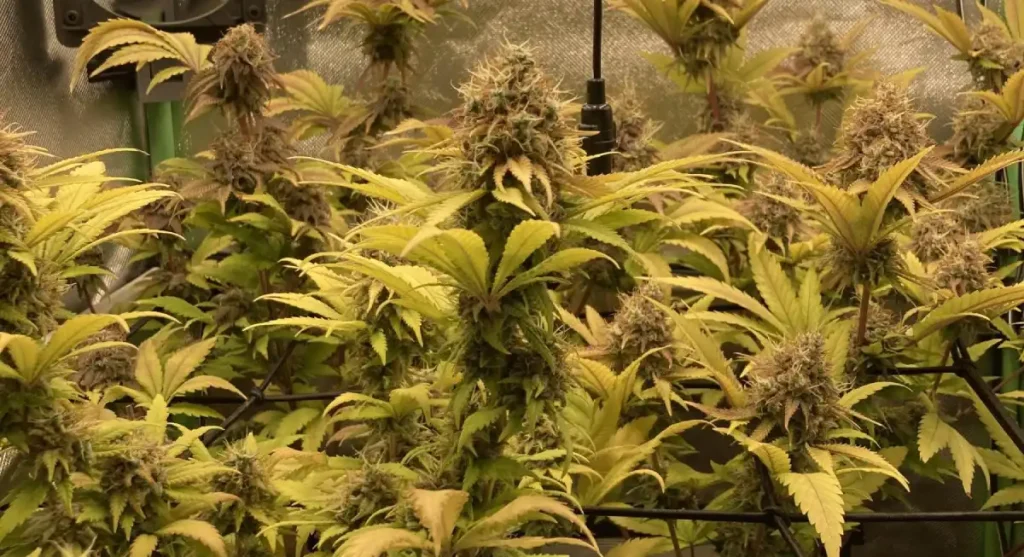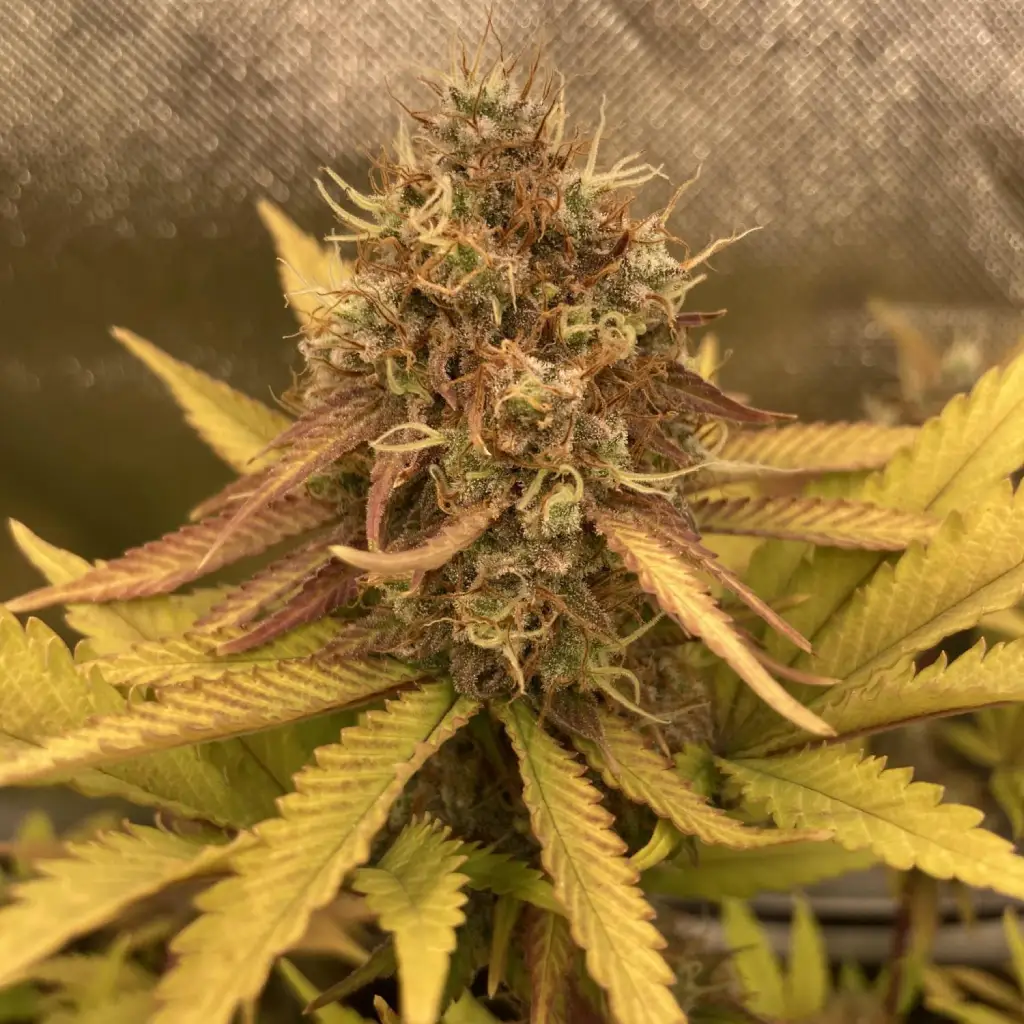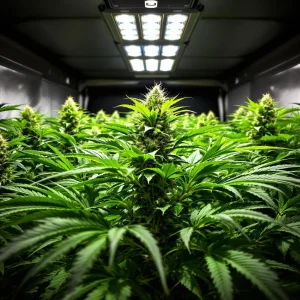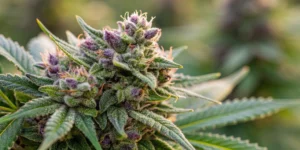Exceptional Genetics and Effects
Kalashnikova Strain, a powerful hybrid that combines the legendary genetics of AK-47 and White Widow, is celebrated for its balanced effects and robust growth. Its potent effects offer both physical relaxation and mental clarity, making it a favorite among recreational and medicinal users alike. The strain’s buds are dense, resin-rich, and emit a pungent aroma with notes of citrus and earthiness. Its rich terpene profile adds depth to its unique sensory experience, appealing to connoisseurs and novice users alike.
Kalashnikova Strain is a delight to grow, thanks to its resilience and high yields. Its balanced genetic lineage ensures vigorous growth and adaptability, making it suitable for various growing conditions. With THC levels ranging between 18-22%, this strain delivers a potent yet manageable experience for users of all levels. The strain’s reliable performance in diverse environments has earned it a reputation as a grower’s favorite.
Environmental Requirements for Growing Kalashnikova Strain
Kalashnikova thrives in a stable environment with controlled temperature and humidity. During the vegetative stage, maintain temperatures between 68-77°F (20-25°C) with 50-60% humidity. During flowering, reduce humidity to 40-50% to prevent mold and mildew.
Ensure good airflow with oscillating fans and exhaust systems to maintain a healthy growing space. Whether grown indoors or outdoors, consistent light exposure is crucial. For optimal results, provide at least 18 hours of light daily during the vegetative stage.
Setting Up The Growing Cannabis Space
Indoor Cannabis Cultivation
For indoor growers, Kalashnikova Strain performs best in a controlled environment with full-spectrum LED lights. Use a light cycle of 18/6 for the vegetative stage and 12/12 for flowering. The strain thrives in well-aerated soil or hydroponic systems with consistent pH levels between 6.0-6.5.
Adequate ventilation prevents heat buildup and ensures even CO2 distribution. Regularly monitor temperature and humidity to avoid stress on plants. Training techniques like topping or low-stress training (LST) can enhance light penetration and boost yields.
Outdoor Cannabis Cultivation
Outdoors, Kalashnikova Strain flourishes in sunny, Mediterranean-like climates. Plant in nutrient-rich, well-draining soil and ensure plants receive at least 6-8 hours of direct sunlight daily. Use stakes or trellises to support branches as buds develop. Proper support systems prevent damage from heavy flowers and optimize light exposure.
Protect plants from pests and extreme weather with natural barriers or companion planting. Regular watering and organic fertilizers promote healthy growth and maximize yields. Harvest typically occurs in late September to early October in the Northern Hemisphere.
Propagation and Germination of Kalashnikova Strain
Start with high-quality Kalashnikova seeds. Germinate using the paper towel method by placing seeds between damp paper towels in a warm, dark area. Once taproots appear, transfer them to small pots with seedling soil. Gentle handling during this stage prevents root damage and ensures a healthy start.
Keep the soil moist but not waterlogged, and provide gentle light to encourage healthy growth. As seedlings develop their first true leaves, transplant them into larger containers or their final outdoor location. Gradually acclimate seedlings to outdoor conditions to minimize transplant shock.
Vegetative Phase of Kalashnikova Strain
During the vegetative phase, focus on promoting strong stem and foliage growth. Provide nitrogen-rich nutrients and maintain a consistent light cycle of 18/6. Regular watering and proper spacing ensure healthy root and leaf development.
Pruning lower leaves and topping the plant can help manage its height and improve light penetration. Monitor for signs of pests or nutrient deficiencies and address issues promptly to avoid stunting growth.
Flowering Phase of Kalashnikova Strain
During the vegetative phase, focus on promoting strong stem and foliage growth. Provide nitrogen-rich nutrients and maintain a consistent light cycle of 18/6. Regular watering and proper spacing ensure healthy root and leaf development. Healthy root zones are essential for nutrient uptake and overall vigor.
Pruning lower leaves and topping the plant can help manage its height and improve light penetration. Monitor for signs of pests or nutrient deficiencies and address issues promptly to avoid stunting growth. Early training techniques improve the plant’s structure and maximize future bud sites.
Cannabis Fertilization and Nutrition – Kalashnikova Strain
During the vegetative phase, use fertilizers high in nitrogen to support leaf growth. Transition to bloom-specific nutrients rich in phosphorus and potassium during flowering. Organic amendments like bat guano or kelp meal can enhance flavor and potency.
Avoid overfeeding to prevent nutrient burn. Regularly flush plants with clean water to remove salt buildup and improve the final product’s quality. Maintaining the correct pH levels ensures efficient nutrient absorption.
Pest and Disease Control for Cannabis Growing
Prevention
Maintain a clean growing environment to minimize the risk of pests and diseases. Use neem oil or insecticidal soap as natural deterrents. Companion plants like marigolds can help repel common pests such as aphids and spider mites. Regular sanitation practices create an inhospitable environment for harmful pests.
Corrective Actions
If infestations occur, isolate affected plants and treat them with organic insecticides or beneficial insects like ladybugs. For fungal issues, trim infected areas and improve airflow to prevent further spread. Regular monitoring is key to early detection and intervention. Prompt corrective actions ensure minimal damage and recovery.
Harvesting and Curing for Cannabis Growing
Harvest Kalashnikova when trichomes turn milky with some amber hues. Use sharp scissors to cut branches and hang them upside down in a dark, ventilated space. Maintain humidity levels around 50% and temperatures between 60-70°F (15-21°C). Proper drying conditions preserve cannabinoid and terpene content.
After drying for 7-10 days, cure buds in airtight glass jars, opening them daily for the first week to release moisture. Proper curing enhances flavor, aroma, and potency, ensuring a premium-quality product. Long-term storage requires stable conditions to maintain freshness.
Is Kalashnikova Strain Indica or Sativa?
Kalashnikova is a balanced hybrid with both indica and sativa characteristics. Its effects combine the cerebral stimulation of sativas with the physical relaxation of indicas, making it versatile for day or evening use. The strain’s adaptability suits a variety of user preferences and needs.
Advantages of Growing Kalashnikova Strain
Kalashnikova offers numerous benefits, including high yields, robust growth, and resilience against pests and diseases. Its balanced genetics make it suitable for a wide range of climates and cultivation methods. These attributes make it ideal for both novice and experienced growers.
The strain’s potent effects and unique flavor profile make it a favorite among growers and consumers alike. Its fast flowering time is an added advantage for those seeking quick harvests. The combination of ease of growth and high-quality results enhances its appeal.
Disadvantages of Growing Kalashnikova Strain
Despite its many advantages, Kalashnikova has a few challenges. Its vigorous growth may require frequent pruning and training to manage height and optimize yields. Beginners may find its nutrient needs demanding. Attention to detail is essential for success.
Additionally, the strain’s dense buds are prone to mold in high humidity environments, necessitating careful humidity control and proper airflow during flowering. These challenges can be mitigated with proactive care and planning.
Problems in Cultivating Kalashnikova Strain
Common issues include overwatering, nutrient deficiencies, and pest infestations. Monitor plants closely and adjust care routines as needed. Regular inspections help identify problems early and prevent significant damage. Staying vigilant ensures optimal growth and high-quality yields.
Advanced Pest Control for Cannabis Growing
For persistent pest problems, consider integrated pest management (IPM) strategies. Introduce predatory insects like lacewings or use biological controls like Bacillus thuringiensis to target specific pests. Regular sanitation and preventive measures are crucial for long-term success. Combining multiple methods enhances overall effectiveness.

Similar Strains
AK Auto Strain
AK Auto is one of the parent strains of Kalashnikova and a staple in cannabis genetics. This sativa-dominant hybrid is celebrated for its potent effects and balanced high that combines cerebral stimulation with physical relaxation. Its THC content averages around 20%, making it a strong choice for those seeking relief from stress, anxiety, and chronic pain.
AK Auto thrives in both indoor and outdoor environments, offering high yields and a fast flowering time of approximately 8-9 weeks. The strain’s earthy aroma, complemented by hints of sweet and floral notes, creates a sensory experience loved by growers and users alike. Its vigorous growth and resilience make it suitable for growers of all levels.
White Widow Strain
White Widow is another legendary parent strain of Kalashnikova. This balanced hybrid offers a harmonious blend of uplifting mental clarity and soothing physical relaxation. With THC levels ranging from 18-25%, White Widow is perfect for social activities or creative pursuits.
This strain is known for its frost-covered buds that glisten with resin, earning its iconic name. White Widow’s growing requirements are manageable, thriving in various climates and producing generous yields. Its flowering period is around 8-10 weeks. The flavor profile includes earthy, woody tones with a subtle spiciness, making it a classic choice for cannabis connoisseurs.
Critical Mass Strain
Critical Kush is an excellent alternative for those who appreciate Kalashnikova’s high yields and robust growth. This indica-dominant hybrid boasts massive, dense buds that are rich in trichomes. THC levels range between 18-22%, offering a deeply relaxing effect ideal for evening use.
Critical Kush grows well both indoors and outdoors, provided that humidity levels are controlled to prevent mold in its thick buds. With a flowering time of 8-9 weeks, it’s a favorite among growers seeking fast harvests. The strain’s sweet, citrusy aroma combined with earthy undertones enhances the smoking or vaping experience.
Week-by-Week Growth Plan for Kalashnikova Strain
Week 1: Germination
During this week, germinate your Kalashnikova seeds using the paper towel method or directly in a light, nutrient-rich soil mix. Ensure the temperature is between 70-80°F (21-27°C) with a humidity level of 70-80%. Provide gentle light from a fluorescent or LED source to encourage healthy sprouting. Keep the soil consistently moist but not waterlogged.
- Key Tasks:
- Monitor moisture levels.
- Maintain a warm, humid environment.
- Use light watering to avoid root rot.
Week 2: Seedling Stage
Seedlings should develop their first set of true leaves. Maintain temperatures around 70-77°F (21-25°C) with humidity at 60-70%. Provide 18-20 hours of light daily and avoid overwatering. Use a low-strength nutrient solution if needed to support early growth.
- Key Tasks:
- Monitor light distance to prevent stretching.
- Begin using a gentle fan to strengthen stems.
- Inspect for any signs of pests or disease.
Week 3-4: Vegetative Phase Begins
Kalashnikova enters its vegetative phase, growing larger leaves and a stronger root system. Increase nitrogen-rich nutrients to encourage foliage growth. Maintain temperatures at 68-77°F (20-25°C) and humidity at 50-60%. Ensure consistent airflow and light penetration.
- Key Tasks:
- Train plants using low-stress training (LST).
- Prune lower leaves for better airflow.
- Monitor pH levels for optimal nutrient uptake.
Week 5-6: Mid-Vegetative Growth
During mid-vegetation, Kalashnikova will show vigorous growth, requiring more water and nutrients. Keep the light schedule at 18/6 and monitor for any nutrient deficiencies or pest issues. Plants may need support structures if they’re becoming too tall or heavy.
- Key Tasks:
- Adjust nutrient ratios as needed.
- Continue training to manage height and shape.
- Check for consistent light exposure across the canopy.
Week 7-8: Pre-Flowering Stage
Plants start to transition to the flowering phase. Slightly reduce humidity to 50% and ensure proper airflow to prevent mold. Begin introducing bloom-specific nutrients while gradually reducing nitrogen levels.
- Key Tasks:
- Identify and remove any male plants (if growing regular seeds).
- Ensure consistent watering without over-saturating roots.
- Monitor the canopy for even light distribution.
Week 9-10: Early Flowering Stage
Kalashnikova will begin producing pistils and small bud sites. Reduce humidity further to 40-50% and maintain temperatures around 68-77°F (20-25°C). Switch to a 12/12 light schedule and provide nutrients rich in phosphorus and potassium.
- Key Tasks:
- Inspect buds for signs of mold or pests.
- Continue pruning and defoliating as needed.
- Avoid nutrient overfeeding to prevent burn.
Week 11-12: Mid-Flowering Stage
Bud development accelerates, and plants emit their characteristic aroma. Trichome production increases, and buds become denser. Maintain optimal environmental conditions to support healthy flowering.
- Key Tasks:
- Reduce nitrogen and focus on bloom enhancers.
- Monitor trichomes for color changes.
- Use stakes or trellises to support heavy branches.
Week 13-14: Late Flowering Stage
As the harvest window approaches, Kalashnikova’s buds will reach their peak potency. Trichomes should turn from clear to milky, with some amber tones. Avoid drastic environmental changes during this critical stage.
- Key Tasks:
- Begin flushing with plain water to remove excess nutrients.
- Maintain humidity at 40-45% to prevent mold.
- Prepare tools and space for harvesting.
Week 15: Harvest
Harvest Kalashnikova when the majority of trichomes are milky white with amber hues. Use sharp scissors to trim buds and hang them in a dark, ventilated space for drying. Ensure temperatures are 60-70°F (15-21°C) with 50% humidity.
- Key Tasks:
- Perform a clean trim of excess leaves.
- Monitor drying conditions closely.
- Begin curing once buds are adequately dried.
Week 16-17: Curing and Finalizing
Place dried buds in airtight jars for curing, opening them daily during the first week to release moisture. Gradually reduce burping frequency over the next few weeks. Proper curing enhances the flavor, aroma, and potency of Kalashnikova.
- Key Tasks:
- Store jars in a cool, dark place.
- Monitor for mold or excessive moisture.
- Enjoy your premium-quality Kalashnikova harvest!
FAQs About Kalashnikova Strain
What is the THC percentage of Kalashnikova Strain?
Kalashnikova Strain typically contains THC levels ranging from 18% to 22%, providing a balanced potency that caters to both novice and experienced users. The hybrid’s effects are a combination of uplifting cerebral stimulation and soothing physical relaxation. This makes it versatile for recreational use and for alleviating symptoms of stress, pain, and insomnia. Its balanced THC content ensures a manageable experience while still delivering powerful effects.
How long does it take to grow Kalashnikova Strain?
Kalashnikova Strain has a flowering time of approximately 8-9 weeks. For outdoor cultivation, the harvest period usually falls between late September and early October in the Northern Hemisphere. The strain’s fast growth cycle makes it an excellent choice for growers seeking quick turnarounds without compromising yield quality. When provided with optimal conditions, Kalashnikova rewards growers with dense, resin-rich buds that exhibit its signature earthy and citrus aroma.
What are the ideal growing conditions for Kalashnikova Strain?
Kalashnikova thrives in a Mediterranean-like climate with plenty of sunlight and moderate humidity levels. Indoors, maintain temperatures between 68-77°F (20-25°C) during the vegetative stage and reduce humidity to 40-50% during flowering to prevent mold. The strain is highly adaptable, growing well in both soil and hydroponic setups. Regular pruning and training techniques, such as low-stress training (LST), can help maximize light penetration and improve yields. Whether grown indoors or outdoors, this resilient strain is suitable for cultivators of all experience levels.





